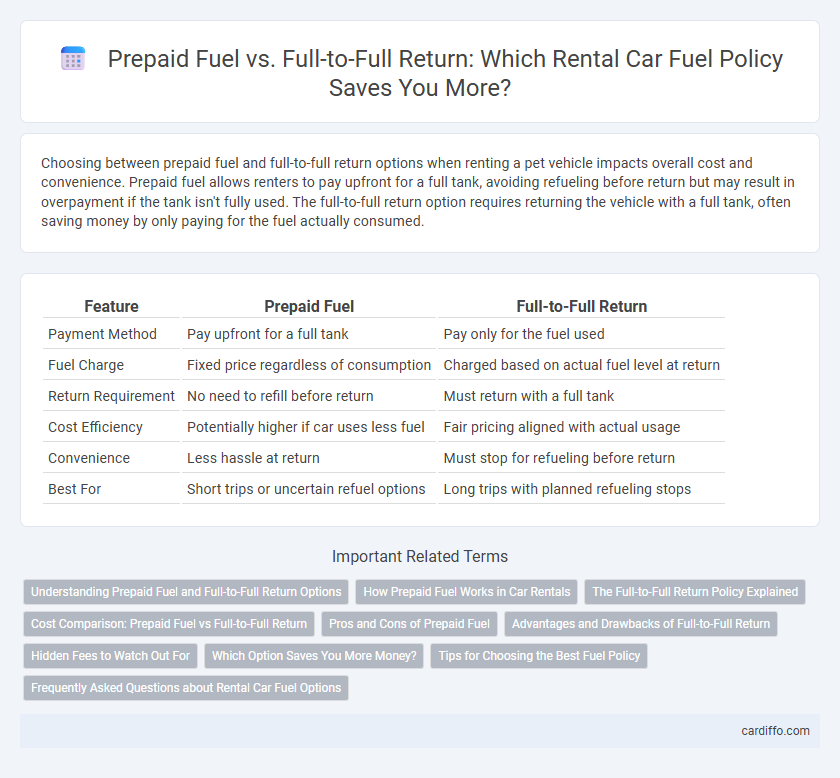Choosing between prepaid fuel and full-to-full return options when renting a pet vehicle impacts overall cost and convenience. Prepaid fuel allows renters to pay upfront for a full tank, avoiding refueling before return but may result in overpayment if the tank isn't fully used. The full-to-full return option requires returning the vehicle with a full tank, often saving money by only paying for the fuel actually consumed.
Table of Comparison
| Feature | Prepaid Fuel | Full-to-Full Return |
|---|---|---|
| Payment Method | Pay upfront for a full tank | Pay only for the fuel used |
| Fuel Charge | Fixed price regardless of consumption | Charged based on actual fuel level at return |
| Return Requirement | No need to refill before return | Must return with a full tank |
| Cost Efficiency | Potentially higher if car uses less fuel | Fair pricing aligned with actual usage |
| Convenience | Less hassle at return | Must stop for refueling before return |
| Best For | Short trips or uncertain refuel options | Long trips with planned refueling stops |
Understanding Prepaid Fuel and Full-to-Full Return Options
Prepaid fuel allows renters to pay for a full tank upfront, offering convenience but often comes at a higher cost if the tank is not fully used. The full-to-full return option requires picking up and returning the vehicle with a full fuel tank, ensuring you only pay for the fuel you consume. Understanding these options helps renters choose the most cost-effective and efficient refueling method for their needs.
How Prepaid Fuel Works in Car Rentals
Prepaid fuel in car rentals allows customers to purchase a full tank of fuel at the start of the rental period, typically at a fixed rate set by the rental company. Renters then return the vehicle with any fuel level, avoiding the need to refill the tank before returning the car. This option offers convenience by eliminating fuel stops, but may result in paying for unused fuel if the tank is not fully consumed.
The Full-to-Full Return Policy Explained
The Full-to-Full return policy requires renters to pick up the vehicle with a full tank of fuel and return it with the same amount, ensuring they only pay for the fuel they actually use. This method avoids hidden fuel charges common in prepaid fuel options, providing transparency and cost control for renters. Understanding the Full-to-Full policy helps maximize savings and prevents unexpected fees during vehicle rental returns.
Cost Comparison: Prepaid Fuel vs Full-to-Full Return
Prepaid fuel options often appear convenient but can result in higher overall costs compared to the full-to-full return method, where renters pay only for the fuel actually used. Full-to-full return allows precise fuel consumption billing, avoiding fees for unused fuel included in prepaid plans. Renters save money by refueling to the tank's original level before return, optimizing cost-efficiency and transparency in fuel expenses.
Pros and Cons of Prepaid Fuel
Prepaid fuel offers convenience by allowing renters to pay upfront and return the vehicle with an empty tank, eliminating the need for refueling before drop-off. This option can save time and prevent last-minute fuel station searches but often comes at a higher cost per gallon compared to local prices, potentially resulting in overpayment. However, prepaid fuel reduces the risk of unexpected refueling fees, providing price certainty for budget-conscious renters.
Advantages and Drawbacks of Full-to-Full Return
Full-to-Full return rental agreements require customers to refuel the vehicle to the original fuel level before returning it, ensuring transparency and avoiding hidden refueling charges. This method promotes fair pricing, as renters only pay for the fuel they use, but it can be inconvenient if the renter struggles to locate a nearby gas station before return. While full-to-full policies reduce disputes over fuel levels, renters must accurately gauge fuel usage to prevent unexpected refueling fees or penalties.
Hidden Fees to Watch Out For
Prepaid fuel options in car rentals often come with hidden fees such as inflated fuel prices and charges for unused fuel, which may not be transparent upfront. Full-to-full return policies require customers to refill the tank before returning but avoid extra fuel service fees, making it more cost-effective if planned carefully. Customers should scrutinize rental agreements for fuel-related surcharges, price per gallon differences, and potential penalties to avoid unexpected costs.
Which Option Saves You More Money?
Prepaid fuel plans often appear convenient but can be more expensive since you pay upfront for a full tank regardless of actual consumption. Full-to-full return requires refilling the tank before return, allowing you to pay only for the fuel you use, which typically results in cost savings. Comparing local gas prices and estimated mileage helps determine which option saves more money on your rental.
Tips for Choosing the Best Fuel Policy
Choosing the best fuel policy requires evaluating your driving habits and trip length; prepaid fuel offers convenience with a fixed cost but may lead to paying for unused fuel, while full-to-full return ensures you only pay for what you use with a need to refuel before return. Analyze rental duration, expected mileage, and local fuel prices to optimize cost efficiency. Always inspect the fuel gauge at pick-up and document it to avoid disputes upon return.
Frequently Asked Questions about Rental Car Fuel Options
Prepaid fuel allows renters to pay for a full tank upfront, avoiding refueling before return but often without refund for unused fuel, making it suitable for convenience over cost efficiency. Full-to-full return requires returning the car with the same fuel level as at pickup, ensuring you only pay for what you use and potentially offering better value if you refill yourself. Common questions address cost comparisons, refund policies for unused fuel, and the risk of additional charges if the fuel level is not accurately topped up before returning the vehicle.
Prepaid Fuel vs Full-to-Full Return Infographic

 cardiffo.com
cardiffo.com